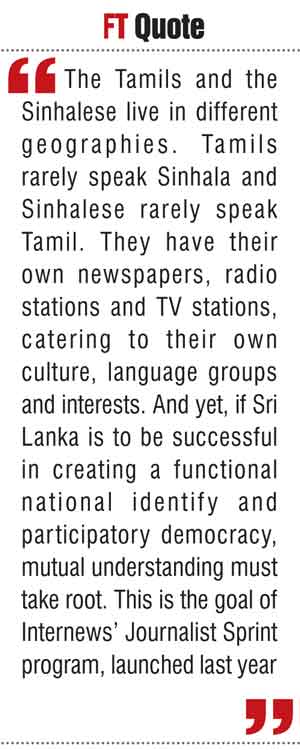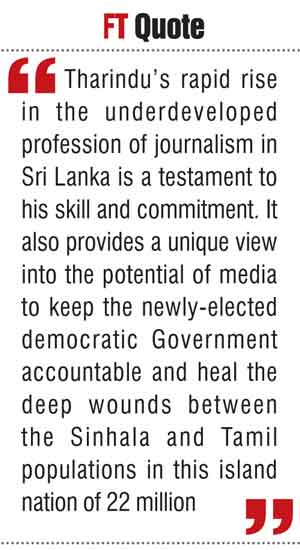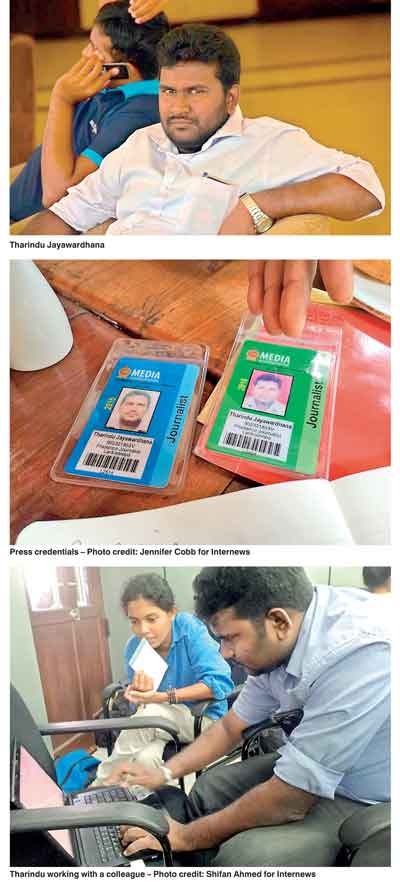Thursday Jan 09, 2025
Thursday Jan 09, 2025
Thursday, 21 April 2016 00:00 - - {{hitsCtrl.values.hits}}

Tamil ex-combatant in Sri Lanka – Photo credit: Tharindu Jayawardhana
By Jennifer Cobb
Sri Lankan journalist Tharindu Jayawardhana completed his formal education in the same year that the 26-year-long civil war in his country ended. Five years later, Tharindu reports for the most widely-circulated Sinhala paper in Sri Lanka, Lankadeepa.
Tharindu’s rapid rise in the underdeveloped profession of journalism in Sri Lanka is a testament to his skill and commitment. It also provides a unique view into the potential of media to keep the newly-elected democratic Government accountable and heal the deep wounds between the Sinhala and Tamil populations in this island nation of 22 million.
 The Sri Lankan civil war, which claimed the lives of almost 100,000 people, plus an estimated additional 40,000 in the final phase of fighting, raged between the insurgent Tamil Tigers seeking a separate Tamil nation on the north and east of the island, and the Sri Lankan military, largely representing the majority Sinhalese population, living mostly in the south and west.
The Sri Lankan civil war, which claimed the lives of almost 100,000 people, plus an estimated additional 40,000 in the final phase of fighting, raged between the insurgent Tamil Tigers seeking a separate Tamil nation on the north and east of the island, and the Sri Lankan military, largely representing the majority Sinhalese population, living mostly in the south and west.
The war was long and bloody, marked by a series of repressive military governments that restricted civil liberties in the name of national security. The media operated under a restrictive environment during the war, and after the defeat of the Tamil Tigers, President Mahinda Rajapaksa and his authoritarian Government restricted media freedoms further, creating a culture of fear and self-censorship among journalists. In January of 2015, the Rajapaksa regime was voted out of office in a popular election, ushering in a hopeful period of democratic reform led by the new President, Maithripala Sirisena.
Tharindu grew up and still lives in Gampaha, a mixed agricultural and light industrial area composed almost entirely of Sinhalese Buddhists about an hour and half outside of Colombo. On our second meeting, at a leafy café in a quiet area of Colombo, he told me that his inspiration for going into journalism started with an early fascination with political talk shows.
Focus on accountability
This fascination has matured into a robust understanding of the power of media to keep the newly-democratic Government accountable.
In 2015, Tharindu joined a media advocacy group, the Young Journalists Association of Sri Lanka, which supports media ethics and uses media to promote justice. Tharindu has been an instrumental force in some of the organisation’s most impressive work.
“Last year there was a case in the Northern Province, in Jaffna, where a young girl was brutally raped and murdered,” he said. “The media splashed her picture all over the place and reported her family’s name and details. We assembled a meeting of senior media leaders, publishers and academics to discuss the ethics around this case.” The response to this advocacy was significant in the media community and Tharindu was inspired to go further. He suggested that the young journalists’ organisation take up a critical case from his home town of Gampaha.
“In a village near my town, Hayleys Group, a major rubber and tea producer in Sri Lanka, had a factory where they made rubber gloves. The company was dumping toxic sludge that seeped into the groundwater and people were falling sick with skin rashes, kidney disease and even blindness. This issue was known as far back as 1997, but the owners were friends of the former Government and nothing was done,” Tharindu explained.
In August of 2013, 5,000 people from 18 local villages turned out to demonstrate. The Rajapaksa Government called in the Army and the local Police and three people, including two students, were killed in the resulting melee. The Rajapaksa Government responded by filing charges against the local demonstrators.
“When the new Government came to power, they did nothing to address this issue though they had promised to provide clean, safe water and remove the charges against the locals and arrest the people who fired against the soldiers,” Tharindu said.
Starting in March of 2015, Tharindu got dozens of the members of the journalists association, representing the press in all three languages (Sinhala, English and Tamil) to produce a steady barrage of stories about the issue. Tharindu uncovered a 2005 report from the Government’s own Human Rights Commission about the environmental issues and published it. The group hosted media briefings and a conference of leading academics and journalists in the village. Even so, by August of 2015 there was no movement from the Government side.
Tharindu then requested a meeting with the President. In December of 2015, the group was granted a meeting with the Coordinating Secretary of the President, where they presented four demands. First, the locals must have clean water. Next, the people who ordered the shooting must be arrested. The people who did the shooting must also be arrested. Finally, the affected people must be provided with compensation. The Secretary promised to honour their demands.
Not content to wait, the association requested a meeting with the local Government in Gampaha, where Tharindu represented their  demands. They named the stakeholders that the Government should to meet with — the Water Board, the Police, and the Military — and provided the exact number of people affected. The Government responded and the President gathered the stakeholders for a meeting where all the demands were accepted by all those present at the meeting. The Government has promised to start providing compensation by 5 April. This process has already begun.
demands. They named the stakeholders that the Government should to meet with — the Water Board, the Police, and the Military — and provided the exact number of people affected. The Government responded and the President gathered the stakeholders for a meeting where all the demands were accepted by all those present at the meeting. The Government has promised to start providing compensation by 5 April. This process has already begun.
This campaign was powerful lesson for Tharindu and his young colleagues on the power of good media to enact change.
“The continuous pressure we applied bore fruit. We wrote articles, letters, held media briefings and conferences. All of these journalists who are part of the association did hard hitting articles questioning the president. It worked,” said Tharindu.
Healing ethnic wounds
At the same time that the environmental rights campaign was being considered by the President, Tharindu met a Tamil person for the first time. He was 24 years old.
This is a rather shocking statement. Yes, Tharindu grew up in a Sinhalese Buddhist community, but by the end of 2015, he had been a working journalist for four years in a country no longer in the midst of a civil war. He was based in Colombo at the country’s largest circulation Sinhalese newspaper. And he had never met a Tamil in his life.
This story offers a clear example of just how divided this country is. The Tamils and the Sinhalese live in different geographies. Tamils rarely speak Sinhala and Sinhalese rarely speak Tamil. They have their own newspapers, radio stations and TV stations, catering to their own culture, language groups and interests. And yet, if Sri Lanka is to be successful in creating a functional national identify and participatory democracy, mutual understanding must take root.
This is the goal of Internews’ Journalist Sprint program, launched last year. Continuing the spirit of this program, Internews has launched the One Sri Lanka Journalism Fellowship, where 40 promising and mostly young journalists of Tamil, Sinhala and Muslim backgrounds are working together to understand each other’s cultures and importantly, the challenges and issues that each ethnic community experiences. The program facilitates mixed teams of journalists to report on stories that they wouldn’t normally report on.
It was in the first Sprint last year that Tharindu got to know his first Tamil peers, his two teammates, both journalists from the north of the country. Together, Tharindu and his team decided to report on the plight of ex-combatants in the north of the country.
Before making the journey, Tharindu thought that the ex-combatants would be anti-Sinhalese and may not treat him well. After all, there was a general assumption, encouraged by the Government, that the Sinhalese had to protect themselves from Tamil Tigers from the North “When we got to the north, I was deeply upset by the living conditions of these ex-combatants. They were very poor  and very helpless. And they were very nice people and deeply gracious to us,” Tharindu said.
and very helpless. And they were very nice people and deeply gracious to us,” Tharindu said.
The story he and his team produced, ‘Then They Held Guns, Now They Battle Hunger Pangs,’ included the following profiles:
“Sathyan [a resident who lost his limb in a mine blast] says that the Tiger badge is hard to shake off, it’s stamped on the former cadres like a branding. He wants to apply to get a prosthetic, but to obtain an Rs 50,000 grant, he needs certification from his village representative. But the form has a line that pledges the applicant has at no time worked against the Sri Lanka Government or Army. With Sathyan’s background, the Government official is reluctant to sign the form.”
“Selvi joined the Tigers when she was 19 because her brother was a cadre who had died in battle. She returned to Kilinochchi hoping for a new life.
But she was in for a rude shock. Her own villagers rejected her; she was used commodity. For some she was a former cadre with the Tamil Tigers, sullied by blood and gore, for others she was a woman brainwashed by the Government. All of them rejected her, some even called her a whore.”
The final story appeared in Sinhalese, Tamil and English newspapers. Tharindu was concerned about the reaction he would get in the South where anti-Tamil sentiment still boils just under the surface.
The reaction was surprising. There were dozens of positive and supportive comments on the website of Tharindu’s paper, the most widely read in Sri Lanka, Lankadeepa.
“I could not have done this story without my Tamil colleagues. I don’t understand the Tamil language. If I went by myself, no one would talk to me because I am from a Sinhala paper and they would have assumed I would not cover their issue properly. Because we were there with our Tamil colleagues, the local people were comfortable and opened up to us,” said Tharindu.
Since that initial experience, Tharindu has recruited his Tamil colleagues to join the Young Journalist Association, which now truly represents the whole of Sri Lanka. Sri Lanka’s media institutions remain ethnically polarised, and Internews is continuing to encourage the commissioning of more stories, using the skills of journalists who are able to collaborate with peers from other ethnic communities and tell stories that cross the divides.
Internews’ One Sri Lanka Journalism Fellowship program will be hosting another round of story production soon where, Tharindu and his Tamil colleagues plan to follow up with another story on the ex-combatants. Some of the people he met reporting the first story have become friends of his on Facebook. They have agreed to be sources for him on the next story.
And so the healing slowly begins.
(Jennifer Cobb is Vice President for Communications and Outreach at Internews.)